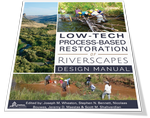Low-Tech Process-Based Restoration
Background to Low-Tech Process-Based Restoration
Synopsis of Topic

Our second project this semester will be a low-tech restoration project.
Why we're covering it
To give you first hand experience in designing, building and developing an adaptive management plan for a real restoration project.
Learning Outcomes
- Gain direct experience applying knowledge as a watershed scientist to working on real-world aquatic ecosystem restoration and management problems (e.g. stream restoration, watershed management, wetland restoration) with practitioners.
- Build a working understanding of the typical process through which restoration projects are designed, constructed, evaluated and adaptively managed.
- Develop a working understanding of different aspects and approaches to restoration design and create two types of design and evaluate their ability to achieve project objectives. Articulate specific, testable design hypotheses for your own designs.
- Get first-hand experience constructing & implementing a ‘cheap and cheerful’ restoration project by building structures you designed.
- Understand the principles of Post Project Appraisals and Monitoring and how to evaluate overall restoration objectives and test design hypotheses.
- Apply the evaluation and adjust loops of an Adaptive Management Plan to see how the process of learning-by-doing can work.
Resources

Low-Tech Process-Based Restoration of Riverscapes: Design Manual (Wheaton et al. 2019)
The definitive source on low-tech process-based restoration. Wheaton J.M., Bennett S.N., Bouwes, N., Maestas J.D. and Shahverdian S.M. (Editors). 2019. Design Manual. Utah State University Restoration Consortium. Logan, UT.
Topics
| Topic | Link |
|---|---|
| 🎯 Intro to Low-Tech Process-Based Restoration | Intro |
| 💣 Planning for Low-Tech PBR | Planning |
Projects
| Project | Link |
|---|---|
| 📁 2018: Three Mile Creek, Utah | Three Mile Creek |
| 📁 2019: Station Creek, Idaho | Station Creek |